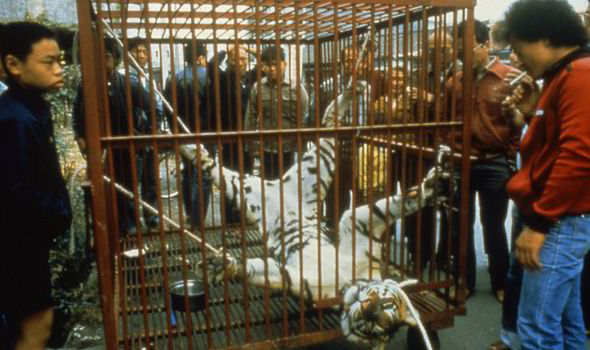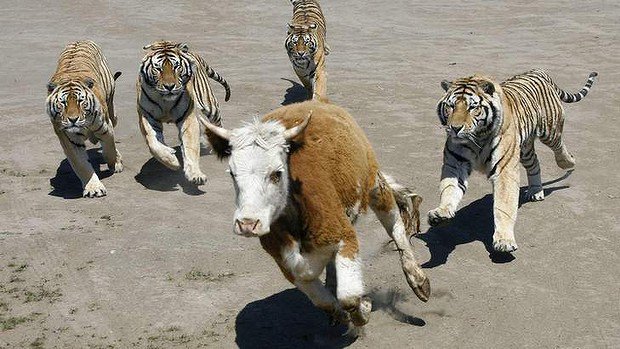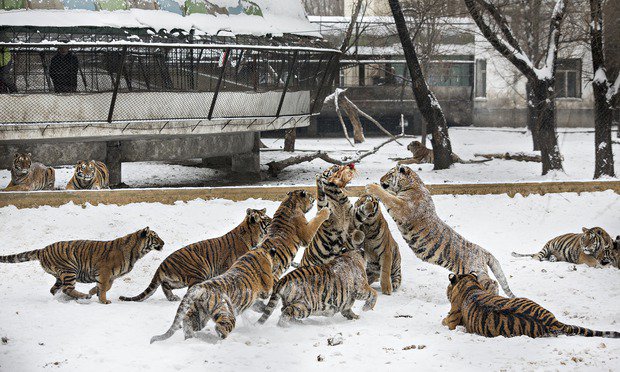As conservationists in India and elsewhere work tirelessly to save the world’s tiger population from dwindling; a population precariously close to extinction, China permits the actual breeding of tigers with the express purpose of harvesting their various body parts: bones, skin and organs. The Chinese appetite for ‘tiger wine’, skins and bones has created actual tiger farms which are threatening the meager remaining world population of this magnificent cat.

The Chinese demand for tiger products
Chinese Tiger Farm Cold Storage – Source National Geographic
Tiger bones ground up for Chinese ‘herbal’ medicines, a bowl of tiger penis soup to boost virility, ground up tiger humerus bone to treat an ulcer, typhoid or rheumatism, tiger eyes to fight epilepsy and malaria… using tiger products is a matter of pride and and a way to display of wealth among the affluent in China, Hong Kong, Taiwan and elsewhere in the Far East.
Tiger poaching is a phenomenon that owes itself largely to the Chinese appetite for products such as Tiger Bone Wine, supposed to cure impotence and other disorders as well as for status symbols products such as tiger skins and stuffed animals. Because of the high demand of products with tiger ingredients, the Chinese have all but eradicated their own natural tiger populations and have made tiger poaching and smuggling a lucrative activity in India and elsewhere.

China’s tiger farms
Tigers are starved and then turned in tiger wine
There is a law in China that forbids the consumption of products containing wild tiger parts so now we have tiger farms where tigers are bred like cattle for the purpose of entertainment and for harvesting their parts. The argument made in defence of these tiger farms is that this will reduce the pressure on wild tiger populations and discourage poaching.

The tigers are bred in cramped conditions much like the poultry industry. Cramped, rusty metal and concrete cages, listless animals, malnutrition and abuse are in evidence here. Cubs are taken away from tiger mothers as soon as they are born so that she will reproduce again quickly. Meanwhile the animals are declawed and de-toothed and are made to perform for human spectators: they lift their paws to ‘beg’, roll over and parade themselves as the men in charge wave sticks at them.
‘Entertainment’ at Tiger Farms

Sometimes live animals such as chickens and cows are released into an enclosure along with the tigers as a means of ‘entertainment’; like a ‘spectator sport.’ There are reports of canned tiger hunts for the rich, yet another form of entertainment where people pay to kill for sport and then feast on the meat of the ‘catch’.
‘Entertainment’ at Tiger Farms
There are an estimated 200 tiger farms in China today, with about 6000 tigers in captivity in these farms. Experts say that these farms are removing the stigma that had become attached to consuming tiger products and this is actually giving a shot in the arm to tiger poaching because demand is actually increasing. Poaching of wild tigers is still cheaper and products of wild tigers coveted more than those from captive bred tigers. Plus tiger farms will never replenish world tiger populations because these animals, being bred in captivity cannot be reintroduced to the wild. These farms provide cover to poaching and incentivise it.
Alas Chinese tiger farms perpetuate the horrific notion that tigers are more valuable dead than alive.
Author – Reena Daruwalla





